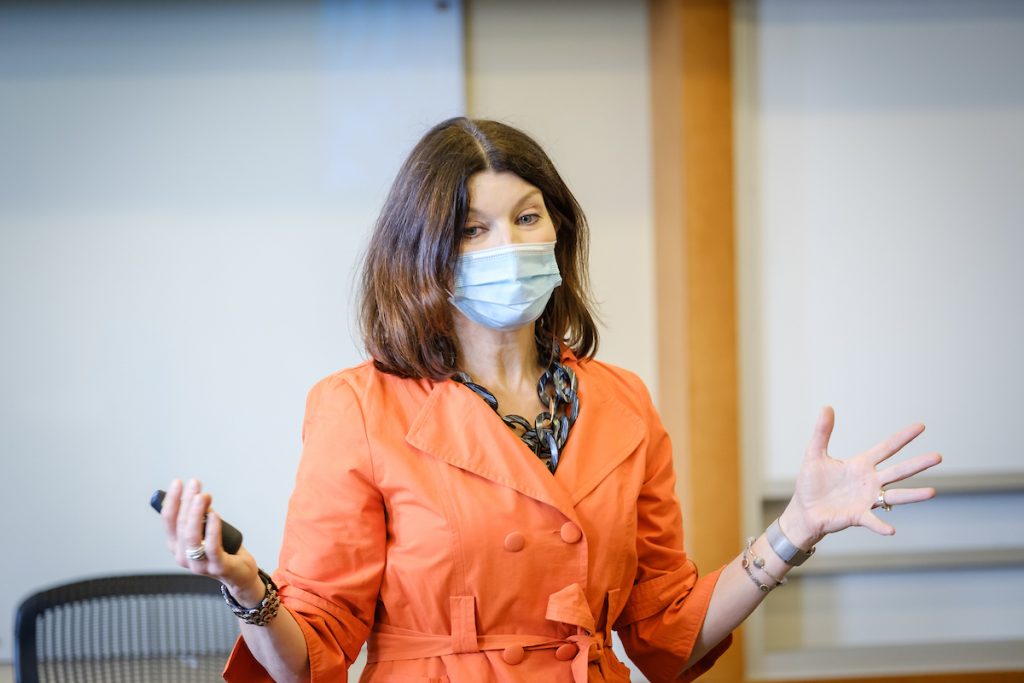Masks in the Classroom: Part 2!

About this time last year, I wrote a short post with a few mask recommendations and tips for teaching in a mask. We’ve learned a lot over the past year, so I thought it might be helpful to revisit this idea again in preparation for fall classes.
Teaching While Masked
Many of you have been teaching in a mask over this last year, so it will come as no surprise that masks present challenges when speaking. They muffle sound, making it difficult to understand high frequency sounds. High pitch consonants such as ‘s’, ‘f’, ‘th’, and ‘sh’ are impacted when our face is covered. Masks also make it difficult for us to read lips and fully see facial expressions. We rely on these when trying to understand someone who is speaking to us.
A few strategies to address these challenges include:
- Encourage your students to speak up when they can’t hear you or one another. Talk to your students about this early on. Model asking others to speak louder or repeat information if you can’t hear to normalize this behavior. Pause occasionally and affirm that students are able to hear you.
- Speak louder (but be sure to avoid vocal strain). Use a microphone (there are even phone apps which will allow you to turn your smartphone into a microphone) or amplifier to help with this. If you have concerns about acoustics and speech reinforcement in classrooms, i.e., being heard because you are wearing a mask, please call 336-758-4357 (HELP) or send an email to the Help Desk (help@wfu.edu) for consultation.
- Speak more slowly. Enunciate and repeat information.
- Pay attention to your breathing and breathe from your diaphragm. This will better allow you to project without straining your voice. Pace yourself and breathe consistently in order to speak clearly.
- Try to reduce other ambient noise in the classroom as much as possible. What can you turn off to reduce noise? Have conversations with your students about the importance of this as well (e.g., less fidgeting, pen tapping, etc.)
- If you use presentations or slides, did you know that you can turn on automatic captions to display the speaker’s words in real time in Google Slides? PowerPoint for Microsoft 365 has a similar feature.
- Be sure to find a mask that fits your face well so that it stays put while you’re talking.
- Consider using a clear mask.
Mask Recommendations
I recently followed a recommendation thread on social media regarding the best masks to wear while teaching. People are very passionate about their masks and have strong opinions about which work best!
Here are a few of the more popular suggestions:
- A number of teachers recommended a KN95 mask because they hold their shape and provide some space between the mask and mouth
- Many favored a basic, disposable, surgical mask
- Old Navy face masks were highly rated as being soft and comfortable (and inexpensive!)
- Happy Masks (Popular, but sell out quickly. They have a restock waitlist you can join)
- Enro Face Mask (also very popular!)
- SartorMasks
- HelmetFitting.com’s SHEMA97 Functional Active Mask
- GATA Mask
- Singer’s Mask from the Broadway Relief Project
- All Keeper KF94 Face Safety Masks
There were also recommendations for silicone inserts/support frames to wear under a mask
- 4ocean face mask support frames
- Enro aerolite
- Silicone bracket for masks
- Nose bridge strips (conform to your nose shape)
I hope you find these suggestions helpful! If you have additional tips or mask recommendations, send them to me at verbekkj@wfu.edu.
References
- American Speech-Language-Hearing Association (2021). Communicating Effectively While Wearing Masks and Physical Distancing.
- Gee, J., & Friberg, J. (Hosts). (2021). Let’s talk teaching [Audio podcast]. Center for Teaching, Learning, and Technology, Illinois State University. https://ctlt.illinoisstate.edu/podcast/2021/ep069.shtml.
- TriCounty Technical College (2020). Teaching while wearing a mask.
- Whitaker, J. (2020). 3 tips on teaching while wearing a mask. News at IU.
Subscribe
Receive CAT blog posts in your inbox.
